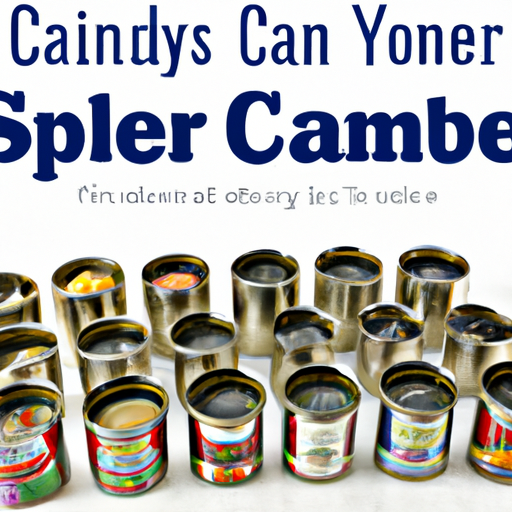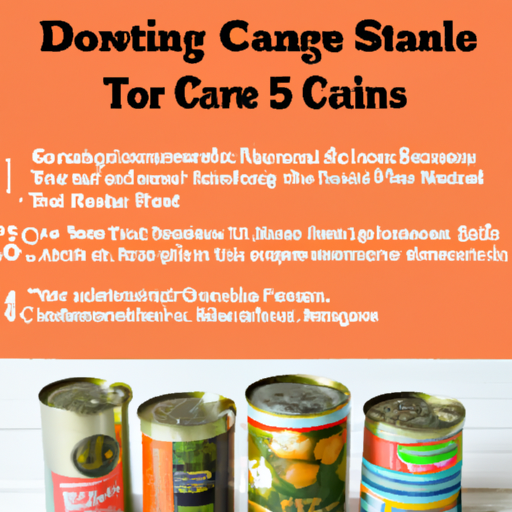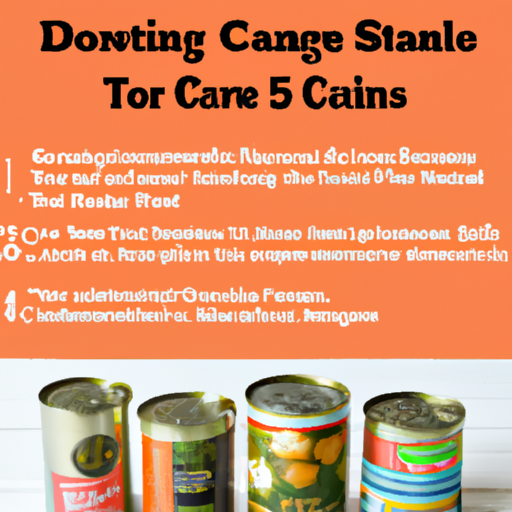Are you someone who loves the satisfaction of canning your own goods, but then finds yourself overwhelmed by the task of organizing and storing them afterwards? Well, fret no more! In this article, we will explore some helpful tips and tricks to make your post-canning process a breeze. From efficient storage methods to clever organizational strategies, you’ll discover the secrets to keeping your canned goods neatly organized and easily accessible. So, whether you’re a seasoned canner or just starting out, get ready to learn some valuable tips for organizing and storing those delicious homemade goodies!

Organizing Canned Goods
Grouping Similar Items Together
When it comes to organizing your canned goods, one effective strategy is to group similar items together. This not only makes it easier to locate specific items, but it also helps in keeping track of your inventory. By grouping items such as vegetables, fruits, soups, and sauces together, you can create designated sections in your storage space, making it more efficient and user-friendly.
Utilizing Storage Containers
Using storage containers is another great way to keep your canned goods organized. Clear plastic bins or crates can be an excellent choice as they allow for easy visibility of the items inside. You can also use stackable containers to maximize space and keep things tidy. Additionally, these containers can help protect your canned goods from dust, pests, and any potential damage.
Arranging by Expiration Date
Arranging your canned goods by expiration date is essential for maintaining their quality and efficiency. By placing the items with the nearest expiration dates at the front of your storage shelves or containers, you can ensure that you use them first and avoid wasting any food. This method, known as the “First In, First Out” (FIFO) approach, helps prevent any cans from going bad and allows you to make the most of your canned goods.
Labeling and Cataloging
Labeling and cataloging your canned goods can go a long way in keeping your storage organized and easy to navigate. Utilize adhesive labels to mark the contents of each can or bin, making it effortless to find what you need. You can also create an inventory list, either digitally or on paper, to keep track of your stock. This way, you’ll always know what you have on hand and what needs to be replenished.
Storing Canned Goods
Choosing the Right Storage Location
Selecting the right storage location for your canned goods is crucial for their longevity. Ideally, you should find a cool, dry, and dark area in your home that is away from direct sunlight, fluctuating temperatures, and humidity. A pantry or a basement can often be suitable options, as long as they meet these criteria.
Temperature and Humidity Considerations
Maintaining the proper temperature and humidity levels is vital for preserving the quality of your canned goods. Ideally, aim for a storage area where the temperature remains between 50°F and 70°F (10°C and 21°C). Avoid areas that are too hot or too cold, as extreme temperatures can affect the taste, texture, and safety of the canned food. Additionally, keep the humidity levels below 50% to prevent moisture buildup and potential spoilage.
Avoiding Direct Sunlight
Direct sunlight can have detrimental effects on canned goods, causing them to lose their nutritional value and quality. Sunlight can generate excessive heat, leading to increased temperature inside the cans and potentially spoiling the food. Therefore, it is essential to store your canned goods away from windows or any other sources of direct sunlight.
Preventing Freezing or Overheating
Extreme temperatures, whether freezing or overheating, can have adverse effects on canned goods. Temperatures below freezing can cause the cans to expand and potentially burst, while excessively high temperatures can lead to spoilage and degradation of the food inside. It is crucial to store your canned goods in a location where they are protected from both freezing and overheating.
Maintaining an Adequate Airflow
Proper airflow is essential to ensure the longevity and quality of your canned goods. Make sure not to overcrowd your storage space, as this can restrict airflow and lead to moisture accumulation. Keep enough space between the cans and allow air to circulate freely, preventing any potential mold or mildew growth. Regularly assess the ventilation in your storage area and make adjustments as needed to maintain an adequate airflow.
Container and Shelf Considerations
Selecting Ideal Containers
When it comes to choosing containers for storing your canned goods, opt for options that are sturdy, airtight, and resistant to moisture. Mason jars, plastic storage containers with secure lids, and metal cans are all suitable choices. Ensure that the containers have no dents or damages that could compromise the integrity of the canned food.
Stacking and Maximizing Shelf Space
Maximize your storage space by utilizing stacking techniques. Stack cans of the same size and shape together, creating neat rows to make the most of your shelves. Make sure to place the heavier cans on the bottom and the lighter ones on top to prevent any potential accidents or damage. Consider investing in stackable storage solutions that can help you make the most of your available shelf space.
Avoiding Overpacking
While it can be tempting to fit as many cans as possible onto each shelf, avoid overpacking. Overcrowding the shelves not only makes it difficult to access specific cans but can also lead to damage or spoilage if the cans are too tightly packed. Remember to leave some space between the cans, allowing for proper airflow and easy retrieval.
Optimizing Shelving Systems
Investing in the right shelving systems can greatly enhance the organization and efficiency of your canned goods storage. Adjustable shelves or modular shelving units can provide flexibility, allowing you to customize the space according to the height and size of your cans. Consider installing additional hooks or hanging racks to make use of vertical space and keep your storage area tidy.
Categorizing Canned Goods
Separating by Food Type
Categorizing your canned goods by food type can be a practical way to find what you need quickly. Divide them into different sections such as fruits, vegetables, soups, meats, and sauces. By keeping similar items together, you can easily locate specific ingredients when preparing meals or recipes.
Organizing by Meal Category
Another approach to categorizing your canned goods is by meal category. Group items that commonly go together for specific meals or recipes, such as breakfast items, lunch options, or dinner staples. This allows you to have a quick overview of the ingredients you have on hand for each mealtime.
Designating Storage Zones
Designating specific storage zones for your canned goods can further enhance their organization. Use shelves or sections of your pantry to create zones for different food categories, such as snacks, baking ingredients, condiments, or emergency supplies. Clearly label each zone to ensure easy identification and maintain an organized storage system.
Creating Inventories or Lists
To keep track of your canned goods inventory, consider creating an inventory or list. This can be done on paper or digitally, depending on your preferences. Include important details such as the name of the item, quantity, and expiration date. Regularly update the inventory as you use or restock your canned goods to stay informed about what you have on hand.

Prioritizing Canned Goods
Rotating Stock with FIFO Method
To ensure that your canned goods always remain fresh, implement the “First In, First Out” (FIFO) method. Place the newly purchased or newly canned items at the back of your storage area, pushing the existing stock forward. This way, you will always use the older cans first, minimizing any risk of food waste or spoilage.
Identifying and Using Aging Products First
As you organize your canned goods, make it a habit to identify and use aging products first. Focus on consuming items that have been in your storage for a longer period, ensuring that they are used before they reach their expiration date. This practice not only reduces food waste but also allows you to enjoy your canned goods at their peak quality.
Setting Aside Emergency or Essential Supplies
In any emergency situation or unexpected event, it is essential to have a supply of canned goods that can sustain you and your family. Set aside a designated area or a separate storage location for emergency or essential supplies. Make sure to regularly check and rotate these items to ensure their freshness and reliability when needed.
Considering Temperature-Sensitive Items
Separating Heat-Sensitive Foods
Certain canned goods, such as chocolate-based desserts or items with dairy components, are sensitive to heat. To ensure optimal quality, it is important to separate these heat-sensitive items from other canned goods. Store them in a cooler area or a separate section of your pantry, away from any potential heat sources.
Storing Cold-Sensitive Items
Just as some items are sensitive to heat, others are sensitive to cold temperatures. Foods like canned beverages or certain fruits can be negatively affected by freezing temperatures. Ensure that these items are stored in a location where they are protected from freezing, such as a pantry or a climate-controlled storage area.
Utilizing Climate-Controlled Storage
For those living in regions with extreme weather conditions, considering climate-controlled storage options can be beneficial. Climate-controlled areas provide consistent temperature and humidity levels, ensuring the optimal conditions for your canned goods. If available, consider utilizing these storage facilities for long-term preservation and peace of mind.
Storing Homemade Versus Store-Bought Canned Goods
Separating Homemade and Store-Bought
When organizing your canned goods, it is important to separate homemade and store-bought items. This helps in keeping track of their freshness and expiration dates. Designate different storage areas or shelves for homemade and store-bought canned goods, ensuring that you use them accordingly.
Differentiating by Labeling or Packaging
To distinguish between homemade and store-bought canned goods, utilize labeling or packaging methods. Clearly mark homemade items with custom labels or stickers that indicate when they were canned. Alternatively, store-bought goods can be differentiated by their original packaging or labeling. This differentiation allows for more efficient inventory management and helps prioritize consumption.
Determining Storage Priorities
Considering the shorter shelf life of homemade canned goods, prioritize their consumption and storage accordingly. Consume these items within a reasonable time frame, focusing on using them before any store-bought cans. By establishing storage priorities, you can ensure that all your canned goods are enjoyed at their best quality and prevent any spoilage or waste.
Utilizing Storing Aids and Accessories
Using Can Racks or Dispensers
Can racks or dispensers are practical storage aids that can help keep your canned goods organized and easily accessible. These storage solutions allow you to stack and organize cans, ensuring that the oldest cans are used first. By implementing can racks or dispensers, you can optimize your storage space and simplify the retrieval process.
Implementing Rotating Shelves
Rotating shelves are an effective way to maximize vertical space and increase accessibility to your canned goods. These shelves typically rotate or spin, allowing you to easily reach and retrieve items from all sides. Rotating shelves are particularly useful for deep pantry spaces or storage areas with limited depth.
Maximizing Vertical Space with Organizers
To optimize vertical space in your storage area, consider using various types of organizers. Wall-mounted racks, hanging shelves, or stackable bins can make use of the vertical space, allowing you to efficiently store and access your canned goods. These organizers can also help in categorizing different types of canned goods, making it easier to find what you need.
Installing Magnetic Spice Racks
If you’re looking for additional storage options for smaller canned goods, consider installing magnetic spice racks. These racks can be attached to the inside of cabinet doors or on the pantry wall, providing a space-saving solution for storing spices, herbs, and other small canned items. Magnetic spice racks ensure easy visibility and accessibility to these often-used ingredients.
Creating a System for Accessibility
Frequency and Accessibility Considerations
When organizing your canned goods, it is essential to consider frequency of use and accessibility. Place frequently used items within arm’s reach, ensuring easy access when cooking. Less frequently used items can be stored in areas that require less frequent retrieval. By organizing your storage space based on usage frequency, you can streamline your cooking process and save time.
Accessible Storage for Regular Use
For canned goods that you use daily or on a regular basis, consider utilizing easily accessible storage solutions. Open shelving or transparent bins can make it effortless to see and grab the items you need. By setting up accessible storage for regular use, you can efficiently stock your pantry and maintain an organized cooking routine.
Long-Term Storage for Emergency Needs
While accessible storage is crucial for day-to-day use, it is equally important to have a designated area for long-term storage of canned goods for emergency needs. Whether it’s a separate storage room, a basement, or a pantry shelf, make sure to regularly check and rotate these items to guarantee their freshness and suitability for emergencies. Consider labeling these storage areas to ensure that everyone in your household knows where to find essential supplies.
Maintaining the Quality of Canned Goods
Inspecting for Damaged or Leaking Cans
Inspecting your canned goods for any signs of damage or leakage is essential in maintaining their quality and safety. Before storing them, thoroughly examine each can, checking for any dents, bulges, or visible damage. Discard any cans that show signs of compromise, as they may indicate potential spoilage or contamination.
Checking for Signs of Spoilage or Contamination
Regularly check your canned goods for any signs of spoilage or contamination. This includes inspecting for changes in color, texture, or odor. If you notice anything unusual or suspicious, err on the side of caution and discard the affected cans. Consuming spoiled or contaminated food can lead to health risks, so it is crucial to maintain a vigilant eye over your stored canned goods.
Controlling Pests and Vermin
Pest and vermin infestations can lead to damage and contamination of your canned goods. To prevent such problems, ensure that your storage area is clean and free from any food debris or spillages. Seal any potential entry points to keep pests out and consider using traps or deterrents if necessary. Regularly inspect your storage area for any signs of pest activity and take immediate action if required.
Performing Regular Inventory Check
Lastly, performing regular inventory checks is important in maintaining the quality and organization of your canned goods. Remember to check your stock periodically, ensuring that all cans are accounted for and still within their expiration dates. Rotate your inventory, prioritizing the consumption of the oldest cans first. By regularly reviewing and updating your inventory, you can enjoy your canned goods at their best quality while minimizing food waste.
In conclusion, organizing and storing canned goods effectively not only ensures their longevity but also simplifies your meal preparations and contributes to an efficient kitchen routine. By grouping similar items together, utilizing storage containers, arranging by expiration date, and labeling your cans, you can create an organized and easily navigable storage system. Consider factors such as the right storage location, temperature and humidity considerations, and the prevention of freezing or overheating to maintain the quality of your canned goods. Container and shelf considerations, categorizing by food type or meal category, and prioritizing stock rotation are all important elements of a well-organized storage system. When dealing with temperature-sensitive items, separate heat-sensitive and cold-sensitive foods while utilizing climate-controlled storage if necessary. Additionally, when storing homemade versus store-bought canned goods, make sure to differentiate and determine storage priorities. Utilize storing aids and accessories, create a system for accessibility, and maintain regular inspections and inventory checks to ensure the quality and safety of your canned goods. With these tips and strategies in mind, you can enjoy the convenience and peace of mind that come with a well-organized and efficiently managed canned goods storage system.
